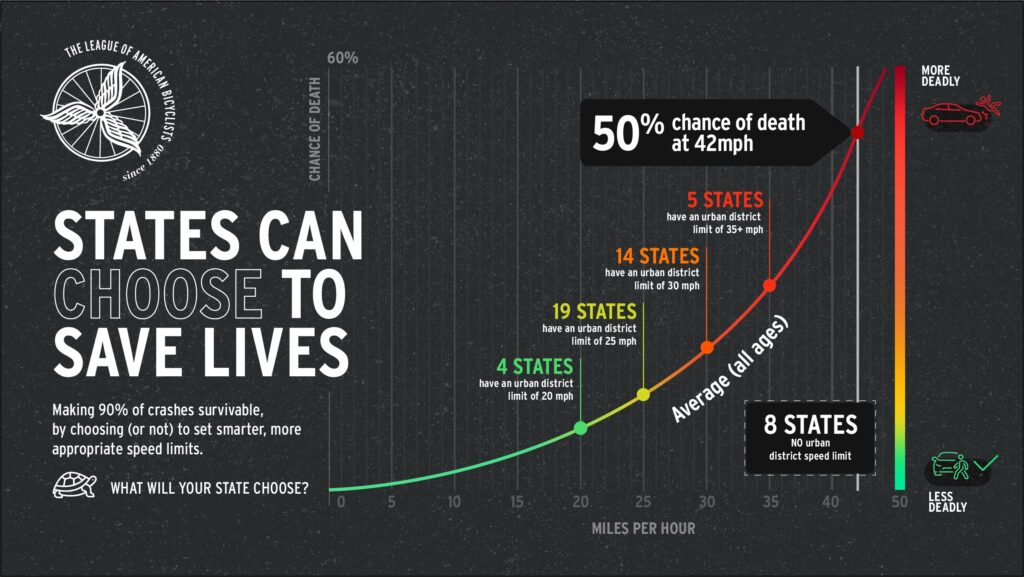DISCOVER YOUR LOCAL BICYCLING COMMUNITY
Find local advocacy groups, bike shops, instructors, clubs, classes and more!
2024 State Speed Legislation: Letting Locals Lower The Limit
In April 2024, the National Highway Traffic Safety Administration (NHTSA) released fatality data from 2022 showing increases in the number of people killed by drivers while biking or walking. The 8,627 people killed while walking or cycling is the highest since NHTSA’s Fatality Analysis Reporting System (FARS) started reporting data in 1975.
Given the historic number of traffic fatalities in 2021 and 2022, the League remains committed to creating slow, safe, and inclusive roads that prioritize the well-being of all users, including people inside and outside of cars, by preventing crashes and minimizing the impact of any that do occur. As part of our Slow Roads advocacy, we encourage states to adopt laws that enable localities to create these slow and safe roadway environments for all users in their communities — and we are seeing states respond to residents’ demands for slower speeds.
Like last year, 2024 has seen several states introduce legislation that promotes lowering speed limits and creating safer environments in areas where vehicles, pedestrians, and cyclists mix. Let’s dive in!
Local Authority Legislation
Maryland, HB 0612 would give local authorities in Montgomery County the ability to decrease the speed limit on a highway—defined in Maryland as any road open to vehicular travel—without needing to perform traffic and engineering studies. This piece of legislation would also authorize county entities to implement new speed monitoring systems on a highway for which the speed limit has been decreased. This bill has passed the Maryland State House and awaits its fate in the Senate.
Maryland, HB 0193 has been signed into law. This legislation authorizes Anne Arundel County and municipalities in the county to decrease the speed limit to 15 miles per hour on highways after performing an engineering and traffic investigation. This law also prohibits county entities from implementing new speed monitoring systems on highways where the speed limit has been decreased.
New Hampshire, HB 1550 would authorize municipalities to reduce speed limits seasonally to provide safe conditions upon any part of the municipal highway system that is seasonally congested by pedestrian or bicycle traffic after conducting the proper studies. This piece of legislation has passed both chambers in the state legislature and awaits approval from the governor.
New York, SB 2422, or “Sammy’s Law,” was back in the NY legislature this year after not passing in 2023. The legislation was incorporated into New York’s budget and will become law in the Empire State. The bill would allow for cities with a population of one million or more (including NYC at 8.3 million people) to lower speed limits to 20 mph by easing restrictions that currently prevent New York City from doing so.
Virginia, HB 1071 passed both chambers and awaits the governor’s approval. This legislation would provide authority for any locality to reduce the speed limit as low as 15 miles per hour on highways within its boundaries that are located in a business district or residence district — including highways within the state highway system. The bill also authorizes a locality to restore a speed limit.
The Campaign Continues
The steady increase of cyclists and pedestrian fatalities is unacceptable. The League of American Bicyclists recognizes the pivotal role of speed in traffic safety, especially where cyclists, pedestrians, and vehicles share roads, increasing the likelihood of contact.
At speeds of 20 mph or lower, 90 percent of individuals hit by vehicles are likely to survive, but at 30 mph, this drops to 75 percent.
Higher speeds, whether due to speed limits set at unsafe speeds or driver behavior, significantly decrease the chances of survival for those struck by vehicles.
Joining global public health organizations and municipalities who have already embraced slowing down, the League advocates for reducing speeds to 20 mph or less in areas where vehicles interact with cyclists and pedestrians. We aim to collaborate with state and local groups to prioritize safety and lower speed limits in urban and residential zones.
The League is focused on slowing speeds on streets where pedestrians, cyclists, and vehicles coexist, rather than on highways or limited-access roads. Join us for our next webinar, “Setting Speeds for Health and Safety“ on June 11th, and stay tuned for future Slow Roads Save Lives campaign programming and opportunities to advocate for safer, slower roads in our communities.
